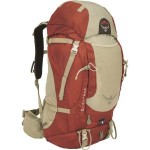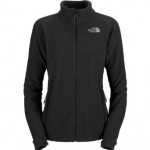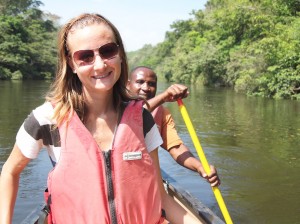Posts by Megan
How I got started in freelance travel writing

In 5th grade, a travel writer came to visit my class in rural Wisconsin. He talked about spending francs in Paris and exotic Africa. Some of my classmates seemed bored, longing for recess, but I was enthralled. Better still, he was paid to write about his experiences. I’d never heard the term travel writer before that day. To me, it was a small miracle that such a career even existed. I vowed I would grow up and become a travel writer. Of course, reality and fear eventually kicked in around high school. I pushed aside the idea of travel writing as a childhood dream, something only a few lucky people could do. I went to college to study social work and considered myself fortunate that I’d been able to study abroad twice.
Fate intervened. Before graduation, I rekindled another forgotten childhood dream: The Peace Corps. Without my social work degree, I never would have been accepted and sent for two years to work with youth in Paraguay.
Long term volunteering abroad
Peace Corps was where I began to hone all the skills I now rely on as a “professional traveler”. Beyond learning Spanish and a few swear words in the indigenous language of Guarani, I figured out that people in other countries aren’t dangerous. I learned to stay in strangers’ homes, eat their food, and talk to them. I figured out how to use public transportation, deal with stomach upsets, and prevent my stuff from being stolen. I learned that even when the worst things happen, (like the time I got diarrhea in prison), I could bounce back and turn it all into a great story. I got used to being homesick, expecting the unexpected, and going with the flow. I searched out the unusual and the overlooked because that is where all the good stories are.
Travel writing began to creep back into my consciousness. But fear still reigned. I would never be a good enough writer. I was a good traveler; I had proved that in Peace Corps and then on a subsequent trip to Southeast Asia and China. But maybe, just maybe, I could write a travel memoir about Peace Corps and Paraguay?
Learning to write about my travels
I did a surreptitious Google search for “travel writing courses” and came across MatadorU, a program offered by the publishers of Matador Network, one of the largest travel magazines. The more I researched the program, the more I liked it. MatadorU was backed by National Geographic Traveler and had laid the courses out in an approachable way. It looked like I could take the course from anywhere in the world, which was good, because I was finished with Peace Corps and essentially homeless. I’d been accepted to a graduate program for social work in New York City, but wasn’t sure I wanted to go. Again I had to choose between pursuing my dream of becoming a travel writer, or relinquishing it in favor of a safer, more conventional path.
I signed up for MatadorU thinking I could learn a lot about travel writing for my book before proceeding to grad school, without any plans for trying to become a freelance writer. The first thing I had to do for MatadorU was set up a WordPress blog. I loved how easy this new platform was, but I was so terrified of someone stumbling upon my (bad) writing that I used a fake name, “Mega Woo”. With each week’s lesson, my skills – and confidence – began to grow. I wrote a piece about being married in the Peace Corps and was absolutely shocked when a Matador editor emailed me and offered to buy the piece for Matador. A few weeks later I was invited on a press trip in Cabos, Mexico. Then I sold another piece. I was doing it, I was travel writing!
Ever wish you had a good friend who was already established as a travel writer, and could show you the ropes and introduce you to the editors, press agents, and publishers you’d need to know to succeed?
 Matador Networks’ Travel Writing Program is run by one of the largest travel publishing companies—the very same companies you’ll need to pitch to launch your career.
Matador Networks’ Travel Writing Program is run by one of the largest travel publishing companies—the very same companies you’ll need to pitch to launch your career.
Unsurprising then that some of the most successful travel writers got their start studying with this course. It will teach you everything you need to know to launch your career as a travel writer. But more importantly, the contacts you make there will open doors to getting those all-important first published bylines.
Becoming an official freelance travel writer
But I still had that pesky graduate school admission to think of. I moved to New York City and found a walk-up on the Lower East Side. I sat in my window every night until three, writing. I went to the grad school orientation and looked over my class list, but my heart wasn’t in it. I contacted the school and deferred my application. Then I told my parents. They weren’t surprised. Neither was I. I started pitching like mad, realizing I wouldn’t be able to count on student loans to pay my rent. I had to take jobs babysitting and work as a coat check attendant. I didn’t care. I was completely free to do what I wanted for the first time in my adult life. The 5th grader inside of me was so proud.
Still, the 27 year-old with the student loans and Manhattan rent was a little nervous. And occasionally a little voice would ask, ‘who do you think you are?’ I ignored it. I went to the New York Times Travel show with an editor from MatadorU and met the publicists who worked with the Belize Tourism Board. I was on a short list to become a writer-in-residence in Belize. The publicists were very impressed with my Peace Corps experiences. A week later, I signed the contract. I’d be traveling in Belize for three months and writing about my experiences. I found a subletter for my apartment, packed a backpack, and tracked down that travel writer who’d inspired me in 5th grade. I owed him a huge thank you.
Read MoreFreelance Travel Writing Gear: my top 10 must-haves
Once, while sitting by the river and working on my laptop at an eco-lodge in Belize, another guest approached me and said, “Travel writing must be the life – you get paid to vacation and they buy you a free laptop.” There are a few things wrong with his sentence, but the one I’ll focus on here is the “free” laptop. Freelance writers aren’t given the equipment we need to do our job. We buy it ourselves and haul it with us wherever we end up going: camel riding in Morocco, practicing yoga in Mexico, or scuba diving in Belize.
Price is a major factor in deciding what I need to buy, but durability, weight, and multi-functionality matter too. The trick is to invest in gear from the States that I can’t easily find in foreign countries. Notebooks, memory cards, and toiletries are available all over the world, but my core list of crucial items were bought before I got on the plane. Here is a list of must haves to bring with me when I travel.
 Backpack: Osprey Kestrel
Backpack: Osprey Kestrel
Osprey bags are well known for their durability, which was extra important when I had to carry my entire life on my back while I travelled throughout Belize for three months. Rips, tears, or broken zippers weren’t an option – and they weren’t an issue.
 Digital Camera: Olympus PEN E-P1
Digital Camera: Olympus PEN E-P1
What makes the Olympus PEN E-P1 camera the best bet for travel writers is that the camera body is lightweight and discreet, but still takes beautiful photos. The extended battery life allowed me to shoot hours of HD video and hundreds of still shots in Belize’s Mayan villages with zero access to electricity.
 Laptop Computer: Apple MacBook Air
Laptop Computer: Apple MacBook Air
I’m a firm believer that anything I take with me on a trip has a good chance of not coming home with me. I proved I’m okay with that when I left my iPhone in Morocco. But if anything were to happen to my MacBook Air, I’d be devastated, and not just because of its high price tag. As a blogger, my light as air MacBook Air is my business partner and best friend. For me, the cost is justified because I don’t get a sore shoulder from lugging a bulky computer everywhere, and the MacBook Air is lightning fast, which saves me time.
 Mini Stapler
Mini Stapler
While in Morocco, I collected hundreds of business cards, menus, flyers, receipts, and promotional materials because that information becomes vital when writing articles after the trip. The easiest way to organize all that loose paper is to simply staple it into a notebook. Voila. Organized.
 Business Cards
Business Cards
I wish I’d printed out business cards earlier in my career. Having my name, contact information, and website on one little card is much more professional and organized than scribbling on a scrap of paper. In Latin America especially, business cards are a requirement. Not having one reads as amateur. Exchanging cards with anyone from hotel owners to interview subjects is as necessary as a handshake, mostly for formality.
 Smartphone: Apple iPhone
Smartphone: Apple iPhone
A smartphone is like a miniature laptop that fits in my pocket. When I’m traveling I can quickly access travel apps and email, and take photos for my social media platforms. In New York City, I use it constantly to navigate the subway system. Oh, and that Starbucks app? Perfect for finding the nearest free bathroom.
 Headlamp
Headlamp
Headlamps are the ultimate hands-free device. In Paraguay, I used my headlamp every night on my way to the dark latrine. In Belize, I put it to good use exploring wet and dry caves. And I can’t forget all those nights it illuminated my travel journal as I wrote down my latest stories.
 Outerwear: NorthFace Fleece Jacket
Outerwear: NorthFace Fleece Jacket
I spend very little money on clothing. Most of my travel stuff is destroyed in months and left in whichever country I’m visiting, but I made an exception with my NorthFace Fleece. It’s durable, washes well, and adds a layer of warmth without much bulk – features that more than justify the precious space it takes up in my backpack. I’ve worn it biking in China, hiking in northern California, and on the windy beach in Uruguay.
 SeatoSummit garment bag
SeatoSummit garment bag
I only pack one backpack when I travel, which means my hiking boots, emergency snacks, and underwear float around in one big compartment. Not cool. SeatoSummit garment bags changed all that. I tried them out on a trip to Portland and was able to keep my clothing clean, folded, organized, and away from my dirty shoes and clementine oranges.
 Yoga Mat
Yoga Mat
A yoga mat is my one essential non-essential when I travel. I’ve used it as a makeshift bed in Paraguay and for actual downward dog stretching in Cabo, San Francisco, and Belize. To transport the mat most effectively, I roll it very tight, secure the top with a rubber band, and insert the bottom into the exterior pocket of my backpack designed for a water bottle.



